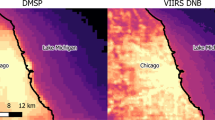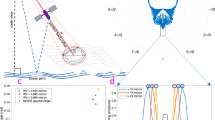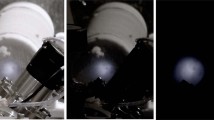Abstract
NOCTILUCENT clouds are very tenuous clouds that appear in the high latitude mesosphere during the summer1. They are seen by scattering of sunlight from cloud particles near the mesopause. They are known to be at altitudes of ∼82 km, more than 50 km higher than the next highest clouds in the atmosphere, the nacreous or mother-of-pearl clouds. They are usually seen after midnight in June and July in the north-east twilight arch at latitudes of 55–65° and appear silvery-blue2 in the red twilight glow. Observations have been made from ground level 3,4, rocket5 and satellites6,7. Studies of sunlight scattered from the clouds have concentrated on measurements of polarisation of the scattered light to allow estimates of the size distribution of the cloud particles to be made. These estimates agree in that only submicron particles with an upper radius limit in the range 0.05–0.3 µm are present. Recent measurements4 of scattered light have shown the presence of a small proportion of circular polarisation, indicating that the cloud particles are probably non-spherical, and estimates of the particle size, being based on the assumption that scattering is from homogeneous spheres (Mie scattering), may need revision. The revision might be enough to force reappraisal of the amount of water condensed to form the clouds and consequent reappraisal of the relative humidity in this part of the atmosphere. A small amount of circular polarisation can be produced in the scattering of natural (unpolarised) light from elongated particles8 but a greater proportion of circular polarisation will arise if the incident light is partly polarised and if the axes of the elongated particles show some directional preference. However, light scattered from spherical particles will also show some small amount of circular polarisation, if the incident light were to be linearly polarised in a direction skewed with respect to the plane of scattering. If the circular polarisation is produced by elongated cloud particles, it is possible that polarisation of the scattered light will show marked differences from place to place due to different proportions and directions of alignment of particles being caused by updraughts or vertical wind shears present in different parts of the cloud region. This would not be expected if the circular polarisation was due to scattering of linearly polarised light from spherical particles. Apart from early photographic observations3, recent measurements of the polarisation in noctilucent clouds have been photoelectric and there has been no simultaneous measurement at different points spread over an appreciable part of the cloud display. We have developed and report here a method which allows us to test how circular polarisation varies over the area of display9.
This is a preview of subscription content, access via your institution
Access options
Subscribe to this journal
Receive 51 print issues and online access
$199.00 per year
only $3.90 per issue
Buy this article
- Purchase on Springer Link
- Instant access to full article PDF
Prices may be subject to local taxes which are calculated during checkout
Similar content being viewed by others
References
Bronshten, V. A. & Grishin, N. I. Noctilucent Clouds (Jerusalem, 1976).
Smyth, C. P. Nature 34, 311–312 (1886).
Witt, G. J. geophys. Res. 65, 925–933 (1960).
Gadsden, M. Ann. Geophys. 33, 363–366 (1977).
Tozer, W. F. & Beeson, D. E. J. geophys. Res. 79, 5607–5612 (1974).
Donahue, T. M. et al. J. atmos. Sci. 29, 1205–1209 (1972).
Willman, C. I. et al. in Optical Investigations of the Emission of the Atmosphere, Aurorae and Noctilucent Clouds aboard the Orbital Scientific Station “Salyuf-4” (Tartu, 1977).
Banderman, L. W. & Kemp, J. C. Mon. Not. R. astr. Soc. 162, 367–377 (1973).
Taylor, M. J. J. sci. Instrum. (in the press).
Crawford, J. thesis, Southampton Univ. (1979).
Shurcliff, W. A. Polarised Light, Production and Use (London, 1962).
Author information
Authors and Affiliations
Rights and permissions
About this article
Cite this article
GADSDEN, M., ROTHWELL, P. & TAYLOR, M. Detection of circularly polarised light from noctilucent clouds. Nature 278, 628–629 (1979). https://doi.org/10.1038/278628a0
Received:
Accepted:
Published:
Issue Date:
DOI: https://doi.org/10.1038/278628a0
Comments
By submitting a comment you agree to abide by our Terms and Community Guidelines. If you find something abusive or that does not comply with our terms or guidelines please flag it as inappropriate.



